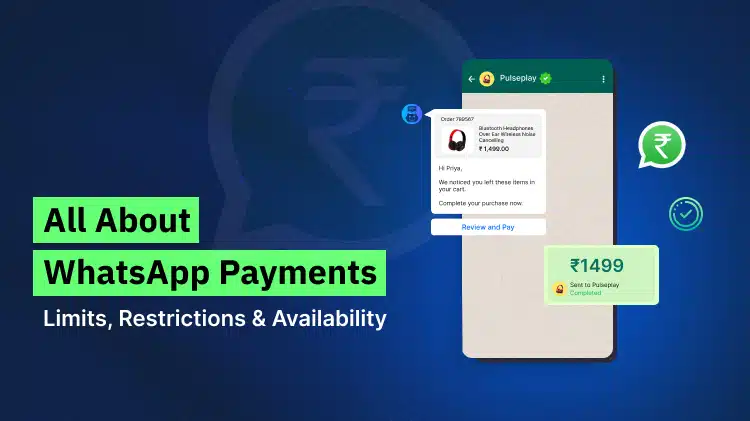All About WhatsApp Payments: Limits, Restrictions & Availability
Money transfers have never been easier. Thanks to the digital revolution now. With just a few taps on your phone, you can now pay rent, split dinner bills, or gift money to a friend—all without leaving your chat window. And if you’re in India, chances are you’ve already come across or must have used WhatsApp Payments.
Designed to make person-to-person money transfers as seamless as sending a message, WhatsApp Payments has steadily gained traction. But just like any financial service, it doesn’t come without rules.
From transaction caps to availability, there are some important limitations that every user should be aware of.
We will discover the most vital questions in this guide as follows:
- What’s the WhatsApp payment limit per day?
- What amount of money I may send or receive?
- What are the restrictions?
- Which countries allow WhatsApp Payments?
- How to remove WhatsApp payment? if you no longer want to use it.
Let’s unfold all this information in simple terms.
Thinking About How Much you Can Send Daily on WhatsApp?
Know the right daily WhatsApp payment limit for you
- A Quick Overview About WhatsApp Payments
- What is the WhatsApp Payment Limit?
- Who Can Use WhatsApp Payments?
- Limitations You Should Know About
- How to Remove WhatsApp Payment from Your App
- Basic Issues and Troubleshooting Tips
- Security Aspect of WhatsApp Payments
- Comparison Between WhatsApp Payments Google Pay, PhonePe & Others
- What’s Next for WhatsApp Payments?
- Will WhatsApp Payments Expand to Other Countries?
- Final Thoughts
- Frequently Asked Questions
Table of Contents
A Quick Overview About WhatsApp Payments
WhatsApp Payment is a feature given by WhatsApp, that enables users in India to send or receive money using UPI (Unified Payments Interface) direct from the app. It’s developed into your chat screen; you can send money instantly via the chat without any extra app or any other process required for processing.
WhatsApp Payments is approved by the National Payments Corporation of India (NPCI), the organization which manages the UPI system used by popular apps- Google Pay, PhonePe, and Paytm.
Its installation is simple. You should link your bank account and give a UPI PIN and done!
This facility comes with restrictions. If you are not aware about them, then you will face issues while transferring your payments via WhatsApp payments.
What is the WhatsApp Payment Limit?
The obvious question arises: How much money you are allowed to send or receive using WhatsApp Payments?
Per Transaction Limit
The highest amount you can send in a single transaction is ₹1,00,000. Either you’re sending money to a family member or paying your rent, this is the limit per transaction.
WhatsApp Payment Limit Per Day
Apart from the per-transfer cap, there’s a daily limit. You can send maximum ₹1,00,000 per day via WhatsApp. So, even if you make multiple smaller payments, the combined total can’t exceed this amount in a 24-hour period.
This WhatsApp payment limit per day is non-negotiable and applies regardless of the recipient or purpose.
Monthly Limit for New Users
If you’ve just started using the feature, you might face a lower monthly cap of ₹20,000. This isn’t permanent—think of it as a probation period until your activity builds some trust with the system.
Number of Transactions Allowed Per Day
You can do 20 transactions per day using WhatsApp Payments only. No matter how much amount you send –Rs.1 or 1000. The limit is set for the day.
These restrictions avoid misuse, fraud, and server overload—also they stick with overall UPI guidelines in India.
Who Can Use WhatsApp Payments?
While the feature is easy to go, Limited access is offered. Find here the qualification criteria:
- A valid Indian mobile number registered with your bank account.
- A bank account in India that supports UPI transactions.
- An updated WhatsApp version is installed on your phone.
- UPI setup completed via WhatsApp, including a working UPI PIN.
If your number isn’t linked to your bank account or if your bank doesn’t support UPI, the feature simply won’t work for you.
Also, this is a personal payments feature—not meant for businesses. If you’re running a business, there are separate options under WhatsApp Business with different terms and conditions.
Limitations You Should Know About
Before use of WhatsApp payments, it is always better to know the limits for the usage to avoid future hassles. Let us roll them down one after the other here:
Currency Support
WhatsApp Payments currently only supports Indian Rupees (INR). That means you can’t use it for sending foreign currency or linking it with non-Indian bank accounts.
So, if you’re abroad or trying to send money internationally, this isn’t the tool for that.
Country Limitations: WhatsApp Payments Countries
Now here’s something a lot of people get confused about—which countries support WhatsApp Payments?
Right now, the full UPI-integrated WhatsApp Payments feature is only available in India.
There have been test runs in countries like Brazil and Singapore, and while some versions of payment features exist there, the Indian version is unique because of its tight integration with UPI.
So, for more clarity: You can enjoy the benefits of WhatsApp payments fully in India for all your UPI- based transfers. Other countries do not have the edge for using the same.
Business Transactions
We’ve said it before, but it bears repeating WhatsApp Payments is not designed for business use. It’s strictly for personal transactions between individuals.
If you try to use it for commercial purposes, you might run into restrictions or even risk violating WhatsApp’s policies.
Bank Restrictions
Also in India, not all banks are working capable with WhatsApp Payments. If your bank does not support UPI, then obviously you can not link your account and hence, will not be able to use WhatsApp Payments.
Fortunately, all leading banks from India support UPI, so WhatsApp payments are possible to use for daily payment processing.
How to Remove WhatsApp Payment from Your App
There could be various reasons you’d want to unlink or remove your payment setup. Maybe you’re not using it anymore. Maybe you’re switching to another UPI app.
Irrespective of your reason, here’s how to remove WhatsApp payment from your account in some easy steps:
Stepwise Guide:
- Start WhatsApp on your phone.
- Tap on the menu icon (three dots) or go to Settings on iPhone.
- Select Payments.
- Choose the linked bank account.
- Tap on Remove Bank Account or Delete Payment Method.
- Confirm your choice.
And just like that, you’ve removed your WhatsApp Payments setup.
Note: This won’t delete your UPI registration with your bank—only the WhatsApp linkage. If you want to delete your UPI ID completely, you’ll need to contact the bank or can delete from the official app of the bank.
Basic Issues and Troubleshooting Tips
Problems are also available in the best systems. Here are some common issues people run into while using WhatsApp Payments—and quick tips to fix them:
1. Can’t Set Up UPI?
- Make sure that your registered number’s SIM card is installed in the primary SIM slot.
- Check that your bank account is active and supports UPI.
- Make sure that WhatsApp has permission to send and receive SMS.
2. Transaction Failing?
- Check again that you haven’t crossovered the WhatsApp payment limit per day.
- Check again for the UPI ID or recipient’s mobile number
- Restart the app or your phone and try again.
3. Delay in Receiving Money?
- Usually, UPI reversals happen within a few working days.
- Contact your bank if the money doesn’t reflect.
- Use WhatsApp’s built-in help option under Payments > Help if needed.
Security Aspect of WhatsApp Payments
It is always a vital question that is WhatsApp payments safe for payment transfers and receipt via WhatsApp. The security is the primary concern here. It is also vital to know whether payments via WhatsApp is as safe as other top trending apps like Gpay, Phone pay etc.
Security Features
Meta owns WhatsApp, obviously, data privacy concerns are mostly raised. Anyhow, WhatsApp strictly follows guidelines given by the National Payments Corporation of India (NPCI).
Here’s how security is handled:
- End-to-End Encryption: WhatsApp chats are encrypted, and while payments themselves are routed via UPI, the payment requests are also secure.
- Device Binding: You may use WhatsApp Payments on the phone number, which is linked to your bank account. This prevents unauthorized logins on another device.
- UPI PIN Protection: Each transaction requires your unique UPI PIN—WhatsApp doesn’t store it, nor does it ever ask for it outside the payment flow.
- Two-Factor Authentication: WhatsApp frequently prompts for your phone’s screen lock (PIN or biometrics) before it allows access to payments.
These measures match with what we would expect from UPI-based apps. WhatsApp includes the edge of contextual transactions—you are paying to the receiver, with whom you’re already chatting with, this is more personalized and intuitive experience.
Comparison Between WhatsApp Payments Google Pay, PhonePe & Others
This is quite interesting. As Google Pay, PhonePe, and Paytm provide same functionality, WhatsApp offers a more integrated experience. Instead of switching between chat and payments apps, the feature is embedded within your existing conversations.
The WhatsApp payment limit per day is the same as that in the other leading apps i.e. 1Lakh. But it does not provide features like bill splitting, QR Code scanning or any cashback offers etc.
Also, when it comes to broader compatibility, apps like Google Pay support more banks and sometimes offer better real-time support. This makes WhatsApp a great tool for casual transfers but perhaps not yet the go-to choose for managing monthly utilities or handling high volumes.
What’s Next for WhatsApp Payments?
With India’s digital payment scene booming, WhatsApp is trying to become the top player. The current limits may feel tight, but they’re likely to evolve as regulations ease and infrastructure improves.
Here’s the future picture:
- Expansion into more countries beyond the current WhatsApp payments countries.
- Integration of WhatsApp Business for seamless business payments.
- Increased limits as trust grows and user volume rises.
But for now, if you’re in India and just want a simple way to transfer money to friends and family, it’s hard to beat WhatsApp Payments for convenience.
Will WhatsApp Payments Expand to Other Countries?
While India is currently the core market, many wonder about WhatsApp payments countries beyond India. The service has undergone trials in Brazil and Singapore, but those implementations differ significantly—often operating through credit or debit cards, not UPI.
For WhatsApp to scale globally, several hurdles remain:
- Local banking regulations
- Cross-border currency support
- Integration with country-specific financial systems
That’s why it’s still limited in scope. But Meta has made it clear they see payments as a key part of WhatsApp’s future. As global regulators warm up to digital finance, we may eventually see an expansion of WhatsApp payments countries, possibly with region-specific features.
Final Thoughts
Sending money should be as simple as sending a message—and with WhatsApp Payments, it is. But as with any financial tool, understanding the limitations is key.
Knowing the WhatsApp payment limit, especially the WhatsApp payment limit per day, can help you plan your transactions better. Being aware of which WhatsApp payments countries support this feature ensures you don’t get stuck trying to use it abroad. And if you ever want to stop using it, it’s easy once you know how to remove WhatsApp payment from your app.
It’s all about making informed choices. With a little knowledge and a few precautions, you can enjoy smooth, secure, and instant money transfers—right from your chat screen.
For queries and requirements regarding WhatsApp Payment, you can drop an e-mail to our WebMaxy experts’ team on: info@webmaxy.co.
Have Queries or Need a Tailored Solution?
The WebMaxy team is just a message away, ready to serve you scale smarter.
Frequently Asked Questions
The daily payment limit on WhatsApp Payments is ₹1,00,000 per day. The limit is fixed even in case of multiple small payments. One must be careful while making a big amount payment via WhatsApp.
Up to 20 transactions per day through WhatsApp Payments are allowed. This includes all UPI transfers made via the app. Achieving this limit level, will restrict to transfer money for the day.
At present, WhatsApp Payments with UPI connectivity to account is only available in India. Countries like Brazil and Singapore have seen pilot versions of it, the experience is limited and works differently there. So, when we talk about WhatsApp payments countries, India remains the most active and supported one for now.
No. WhatsApp Payments is available only for personal use. If you’re trying to receive payments for your business, you need to go for WhatsApp Business integrations, mostly with third-party payment receiving apps.
Yes, WhatsApp Payments is safe and secure. It follows all UPI regulations, uses end-to-end encryption, and needs you to enter a UPI PIN for each transaction. Your payment details are never ever shared with anyone—not even with WhatsApp itself.
To remove WhatsApp Payments, carry out below steps:
1. Go to Settings > Payments,
2. Select your linked bank account and choose “Remove Bank Account”.
It is fast process, and you can revoke the same in case of not interested.
Adam Wilson
Adam Wilson comes with an experience of 12+ years in the IT industry. As a Customer Success Manager, he has been researching and trying to understand the customers’ behavior in different scenarios. He has also studied human psychology to relate it to the purchase journey of the customers. His published books on customer psychology and behavior have received many honors and awards from various enterprises.



